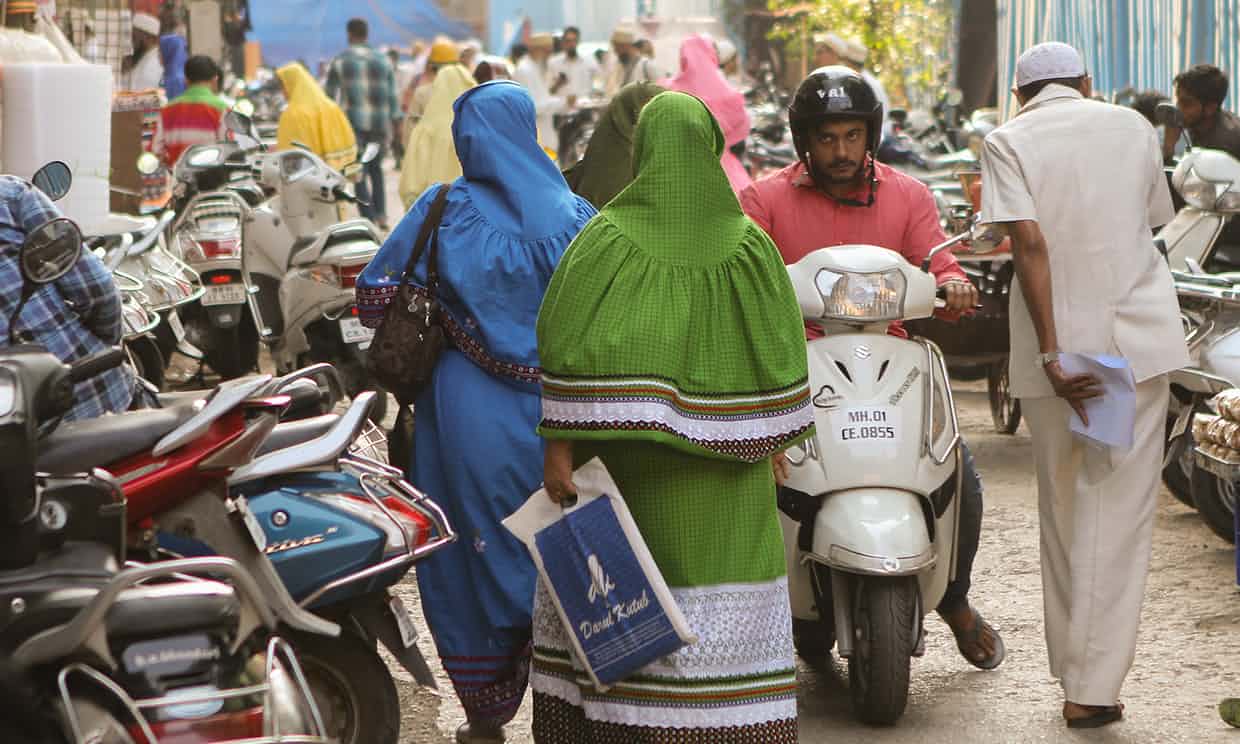'I was crying with unbearable pain': study reveals extent of FGM in India

Bohra Muslim women in central Mumbai. The research shows a high prevalence of FGM among India’s one million-strong Bohra community.
Photograph: Angel L Martínez Cantera
Just weeks after the Indian government declared that there was no data to support the existence of female genital mutilation in the country, a small study has shown a 75% incidence across the Bohra Muslim community.
“My mum told me that a lady would come to remove some extra skin from down there. When the day came, my great-grandmother was holding me tight on her bed,” said 26-year-old “SH”, a law student cited in the report, recalling how she had been cut at the age of seven.
She remembers “sitting on the toilet, crying of unbearable pain, too scared to even pee”. Her mother had reassured her that “everyone in the building has undergone this procedure”, referring to the blocks of flats in Byculla, in the heart of Mumbai, where the Bohra Muslim community has lived for decades.
Her account and those of 83 women and 11 men across five Indian states are included in the first-ever study about female genital mutilation (FGM) in India, compiled by three independent researchers and a coalition of Bohra women against FGM.
The qualitative research, which was released in February, shows the prevalence of FGM among India’s Bohra Muslims – 75% of respondents said they had subjected their daughters to the practice. The survey was conducted with respondents in communities across the states of Gujarat, Madhya Pradesh, Maharashtra, Rajasthan and Kerala.
One of the most recent instances of FGM mentioned in the study was in May 2017, when a 41-year-old woman was reported to have taken her daughter to the hospital because she was “bleeding so heavily [that] the blood had soaked three bedsheets”.
In accordance with the World Health Organization classification, the study reveals that all the affected women had undergone FGM type 1, the partial or total removal of the clitoris.
“Half of them feel some kind of irritation, while 30% either feel discomfort while walking/urinating or have lost sensitivity in the area,” said Dr Sujaat Jenuddin Vali, the obstetrician and gynaecologist who examined Bohra women during the course of the study.
While FGM is well documented worldwide, with one Unicef study estimating that at least 200 million girls have undergone the ritual cutting, in India the tradition is veiled in secrecy.
Bohra girls are often lured by the promise of clothes or sweets to undergo the practice, which is carried out either by mullanis – traditional cutters – or doctors.
Around 1.5 million Bohra Muslims are scattered around several countries, including the UK. In India alone, the Bohra community is believed to number one million. The Shia sect is a minority within India’s Muslim population – 14.2% of the total population, according to the latest census.
Dr Zeenat Shaukat Ali, professor of Islamic Studies at St Xavier’s College in Mumbai, explained that FGM “is not based in Islam and it’s performed solely among the Dawoodi Bohra community”.
Lakshmi Anantnarayan, one of the researchers who conducted the study, said she expected India’s government to produce a law against FGM as a result of her findings.
In response to a supreme court petition to ban FGM in 2016, the ministry of women and child development stated in December that “there is no official data or study which supports the existence of FGM in India”.
“That response is ridiculous because they know our personal stories. The government is in denial and I hope it reconsiders its position,” said 50-year-old Masooma Ranalvi, leading member of WeSpeakOut on FGM, the coalition of Bohra women who commissioned the study and one of the petitioners in the
The WeSpeakOut campaign was established as a platform for survivors and gained momentum after the conviction of three Bohras accused of FGM in Australia, in 2015. As a result, congregations from countries which have anti-FGM laws, including the UK and US, issued notices instructing their followers not to perform khafd – the Arabic term for female genital cutting – as governments “interpreted” it as FGM.
Meanwhile, 17 Bohra women have launched a petition, which has more than 100,000 signatories so far, calling for a ban in India.
The syedna, the main Bohra leader, has encouraged devotees to continue both “male and female circumcision” as their “obligation” to attain “religious purity”.
“Khafd isn’t mentioned in any religious text, particularly in the Qur’an. But some devotees blindly follow the syedna while others are too scared to disobey because they fear they will be ostracised,” said Irfan A Engineer, vice-president of the Central Board of the Dawoodi Bohr Community, a reformist faction of more than 50,000 members around India that has opposed the syedna’s authoritarian leadership for decades.
|